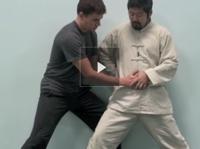 … Next is rotation and spirals. In any of the stances of the circles the weight on the feet is mostly caused by the torso and if your torso moves the weight will change. Therefore if your torso is truly rotating then the centre is not moving and you don’t shift so the weight should remain the same. And if your weight never changes and you are pushing hands, the opponent’s moves must be having no effect.
… Next is rotation and spirals. In any of the stances of the circles the weight on the feet is mostly caused by the torso and if your torso moves the weight will change. Therefore if your torso is truly rotating then the centre is not moving and you don’t shift so the weight should remain the same. And if your weight never changes and you are pushing hands, the opponent’s moves must be having no effect.
Also a rotation keeps the centre intact and a true centre is just a straight line but rotation is not enough you need another direction and that movement is downward. This creates a spiral. All the spiral does is move everything in such a way so that the straight line in the centre moves and remains a straight line.
Using the torso as an example. If your torso were to be rotating and moving downward or spiraling then any force that hits it will only be moving with it. This is because when a force comes in contact with a rotation the rotation is always moving 90 degrees to that force and in physics I learned that every force is made up of component forces. These components are just forces in different directions that when you add them up they are really only in one direction.
However there is no 90 degree component in any force. And the downward movement we do is also 90 degrees so if you move down as much as you rotate then the result is you are moving at a 45 degree angle with depth to the push. And there is so much talk about 45 degrees in Practical Method taiji. So if all body parts moved this way then they would all actually moving in straight lines.


